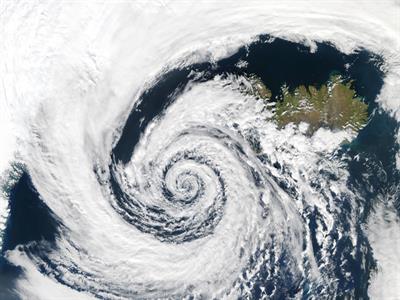PDF chapter test TRY NOW
Periodic or Monsoon winds
As the name denotes, these winds change their direction subject to change in seasons. They are also called monsoon winds or seasonal winds. These winds are caused by the differential heating of land and the ocean. They blow from sea to land in summer due to the low pressure created in the land. And from land to sea during winter. Winds that reverse their direction with the change of seasons are called monsoons.
Example:
Tropical Monsoon winds of the Indian subcontinent
Cyclones
A low-pressure area surrounded by high-pressure wind is called a cyclone.
In other words, cyclones are the centre of low pressure where the air from the surrounding high-pressure region subsides towards the centre in a spiral form. Cyclones rotate anti-clockwise in the Northern hemisphere and clockwise in the Southern hemisphere.
In a cyclone, the pressure circles' pressures (isobars) increases by moving away from the centre.
In a cyclone, the pressure circles' pressures (isobars) increases by moving away from the centre.

Cyclones can be classified into
- Tropical cyclones
- Temperate cyclones
- Extratropical cyclones
Tropical cyclones and their regional names
| Cyclones | Indian Ocean |
| Typhoons | Western pacific ocean |
| Hurricanes | Atlantic and eastern Pacific ocean |
| Baguios | Phillippines |
| Willy willy | Australia |
| Taifu | Japan |
Tropical cyclones often cause heavy loss of life and property on the coasts and become weak after reaching the landmasses.
Temperate cyclones
Temperate cyclones are active above mid-latitudes between\(\ 35°\) to \(65°\) latitudes in both the hemispheres. It is in these latitude zones the polar and tropical air masses meet and form fronts. Temperate cyclones do not become weak like the tropical cyclones on reaching the land.
Temperate cyclone commonly occurs over the North Atlantic Ocean, North-West Europe, Mediterranean basin. Mediterranean basin’s temperate cyclones extend up to Russia and India in winter. In India, it is called western disturbances.
A front is a boundary separating two different types of air masses (generally warm and cold). One type of air is usually denser than the other, with different temperatures and different levels of humidity. This meeting of airmass causes rain, snowfall, hail storm, thunderstorm, lightning cold days, hot days, and windy days.
Extratropical cyclones
Extratropical cyclones occur in between \(30° \)and \(60°\) latitudes in both hemispheres. They are also called mid-latitude cyclones. Energy for these cyclones comes from temperature differences in higher latitudes. Extratropical cyclones produce mild showers to heavy gales, thunderstorms, blizzards, and tornadoes.
